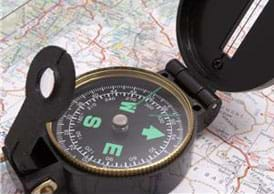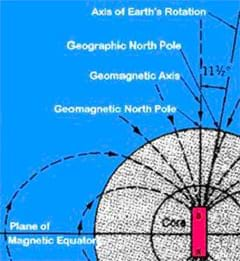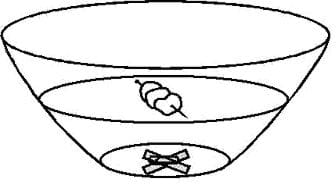Quick Look
Grade Level: 7 (6-8)
Time Required: 30 minutes
Expendable Cost/Group: US $1.00
Group Size: 2
Activity Dependency: None
Subject Areas: Earth and Space, Geometry, Measurement
NGSS Performance Expectations:

| MS-PS2-5 |
Summary
Students create and use their own simple compasses, which are each made from a bowl of water, strong magnet, stick pin and Styrofoam peanuts. They learn how compasses work and about cardinal directions. They come to understand that the Earth's magnetic field has both horizontal and vertical components.
Engineering Connection
Engineers put careful thought into designing compasses that are accurate, precise, durable and inexpensive. To accomplish this, they must thoroughly understand the orientation and strength of the Earth's magnetic field. Scientific concepts such as magnetic declination are important to engineers who design digital compasses that compensate for this effect.
Learning Objectives
After this activity, students should be able to:
- Explain how a compass works and compass directions.
- Explain that the Earth's magnetic field has both horizontal and vertical components.
- Describe the connection between navigation technology (such as digital compasses) and scientific concepts such as magnetic declination.
Educational Standards
Each TeachEngineering lesson or activity is correlated to one or more K-12 science,
technology, engineering or math (STEM) educational standards.
All 100,000+ K-12 STEM standards covered in TeachEngineering are collected, maintained and packaged by the Achievement Standards Network (ASN),
a project of D2L (www.achievementstandards.org).
In the ASN, standards are hierarchically structured: first by source; e.g., by state; within source by type; e.g., science or mathematics;
within type by subtype, then by grade, etc.
Each TeachEngineering lesson or activity is correlated to one or more K-12 science, technology, engineering or math (STEM) educational standards.
All 100,000+ K-12 STEM standards covered in TeachEngineering are collected, maintained and packaged by the Achievement Standards Network (ASN), a project of D2L (www.achievementstandards.org).
In the ASN, standards are hierarchically structured: first by source; e.g., by state; within source by type; e.g., science or mathematics; within type by subtype, then by grade, etc.
NGSS: Next Generation Science Standards - Science
| NGSS Performance Expectation | ||
|---|---|---|
|
MS-PS2-5. Conduct an investigation and evaluate the experimental design to provide evidence that fields exist between objects exerting forces on each other even though the objects are not in contact. (Grades 6 - 8) Do you agree with this alignment? |
||
| Click to view other curriculum aligned to this Performance Expectation | ||
| This activity focuses on the following Three Dimensional Learning aspects of NGSS: | ||
| Science & Engineering Practices | Disciplinary Core Ideas | Crosscutting Concepts |
| Conduct an investigation and evaluate the experimental design to produce data to serve as the basis for evidence that can meet the goals of the investigation. Alignment agreement: Develop a model to predict and/or describe phenomena.Alignment agreement: | Forces that act at a distance (electric, magnetic, and gravitational) can be explained by fields that extend through space and can be mapped by their effect on a test object (a charged object, or a ball, respectively). Alignment agreement: | Cause and effect relationships may be used to predict phenomena in natural or designed systems. Alignment agreement: Models can be used to represent systems and their interactions.Alignment agreement: |
International Technology and Engineering Educators Association - Technology
-
Explain how knowledge gained from other content areas affects the development of technological products and systems.
(Grades
6 -
8)
More Details
Do you agree with this alignment?
State Standards
Colorado - Science
-
Describe methods and equipment used to explore the solar system and beyond
(Grade
8)
More Details
Do you agree with this alignment?
Materials List
Each group needs:
- 1 or more packing peanuts, the non-biodegradable/non-water soluble type; available in recyling bins or at packaging/shipping stores
- 1 plastic bowl or margarine tub, large enough to accommodate the "needle"
- 2 common stick pins
- tap water
- 5 hand compasses, borrow from friends, parents or teachers
- Find Your Own Direction Worksheet, one per student
For groups to share:
- a few strong magnets, available at hardware stores or at https://www.mcmaster.com/
- black electrical tape, 1 roll
Worksheets and Attachments
Visit [www.teachengineering.org/activities/view/cub_navigation_lesson01_activity2] to print or download.Introduction/Motivation
What if you knew you needed to head north to get to a relative's house, but you do not know which way is north? How would you proceed? (Possible answers: Look at where you are going, use a map, use a compass.)
How does a compass locate directions? (Answer: A compass indicates the magnetic field on the surface of the Earth and determines the direction.) A compass is an excellent way to determine how to move in the direction you need to go.
Today, you are going to make a simple compass that really works, one that you can make at home or use in an emergency situation.
Procedure
Background

The first compasses were just lodestones—a naturally occurring magnetic ore—on small sticks placed in bowls of water. This simple device pointed to the pole star and was used for navigation by early mariners. Shortly after the first compasses were used, people discovered that an iron or steel needle that had been touched or rubbed with a lodestone would also align with the pole star.
The Earth's magnetic field has a shape like a strong bar magnet placed near the center of the Earth with its S pole near the north geographic pole and its N pole near the south geographic pole. The Earth's magnetic field, which is three-dimensional, is inclined at about 11 degrees from its axis of rotation. A compass is just a magnet held on top of a pivot so the magnet can rotate freely. A compass points in a direction that lies along the magnetic field at the point. There is also a component of the magnetic field perpendicular to the surface of the Earth.
Before the Activity
- Gather materials and make copies of the Find Your Own Direction Worksheet.
- Read through the activity steps and, using information from the Introduction/Motivation section, have a few relevant questions ready for students. (See the Assessment section for suggestions.)
With the Students
- Hand out the supplies and worksheets to student pairs.
- Direct groups to make an X in the center of the outside bottom of the plastic bowl using electrical tape. Use the tape to determine the four cardinal directions.
- Fill the bowl with enough water (about halfway) so the compass "needle" will be able to move freely.
- Magnetize the needle (a pin) by stroking it two dozen times with the magnet.
- Stick the compass needle (pin) through the center of a packing peanut (the best way to do this is to crush the peanut into a small ball, and stick the pin or needle through the middle. It is okay if only a small bit of the needle is covered by the peanut since the peanut is only necessary as a floatation device for the needle). In some circumstances, more than one packing peanut may be needed.

- Place the needle/peanut assembly into the bowl of water. What happens? (Answer: Expect the magnetized needle to rotate to be oriented north/south. Verify its orientation with a commercial compass.) Have students record answers on their worksheets.
- Have students walk around the room with the compasses they made. What happens to the compass needle as you move about the room? (Answer: Expect it to rotate so that it always points north/south.) Have students record answers on their worksheets.
- Hold the compass flat near the top of any iron or steel object in the room. Note: The most common steel objects in a classroom might be filing cabinets and trash cans, but any object than contains steel—small refrigerators or radiators, for example—works. What happens when the compass is near the topmost part of the object? (Answer: Expect the needle to point at the object.) Move the compass down to the bottom of the steel object, still holding it flat. What happens? (Answer: Expect the needle to flip around 180 degrees.) Record on worksheets.
- Lead a class discussion. Why does the needle point to magnetic north until we bring it close to an iron or steel object? This phenomenon is explained by Newton's law of universal gravitation, which states that any two bodies in the universe will attract each other with a force that is directly proportional to the product of their masses, and inversely proportional to the square of the distance between them. In our experiment, the Earth's magnetic field is very strong compared to the magnetic field of the iron or steel object, so the Earth's field dictates the direction of the needle in most cases. However, the Earth's magnetic pole is far away, so when the needle is brought close to the iron or steel object, the field of that object dominates, since the needle and the object are in close proximity.
- Now have students create a formation. Have students form a large "X" with groups of students pointing toward the four cardinal directions. Use the compass to resolve any disagreement among them.
- Remove the needle and packing peanut assembly from the water.
Assessment
Pre-Activity Assessment
Discussion Questions: Solicit, integrate and summarize student responses.
- What if you knew you needed to head north to get to a relative's house, but you do not know which way is north? How would you proceed? (Possible answers: Look at where you are going, use a map, use a compass.)
- How does a compass locate directions? (Answer: A compass indicates the magnetic field on the surface of the Earth and determines the direction.)
Activity Embedded Assessment
Worksheet: Have students record their activity observations on the Find Your Own Direction Worksheet, beginning when the compass is placed in the bowl of water. Review their answers to gauge their depth of engagement and comprehension.
Post-Activity Assessment
Formation: Have students form a large "X" with groups of students pointing toward the four cardinal directions. Use the compass to resolve any directional disagreement among students.
Safety Issues
- Warn students to be cautious when sticking the pins through the foam packing peanuts because in some cases the peanuts crumble, making it easy to poke fingers.
- Remind students to return their pins to a safe place so they do not wind up on the floor or stuck in the carpet.
Troubleshooting Tips
When magnetizing, students must stroke the needle in one direction only. Rubbing the needle back and forth will not magnetize it strongly. Also, if they do not stroke the needle enough, it will not be strongly magnetized.
Some alert students might also realize that the compass and needle point at a direction that is not true north. This is magnetic north. If students are interested, show a map and the change in inclination for the compass that can be made to compensate and show true north. Magnetic declination is the term for the angle between magnetic north and true north.
Activity Extensions
Take students outside the classroom, to a playground, for instance. Have them use compasses at several directional locations to find magnetic north. Once they have located north, ask them to separate and stand in various locations around the playground with their compasses flat in the palms of their hands. Have them all face the direction their red compass arrow is pointing. Expect them to notice that no matter where on the playground they are standing, they are all be facing the same direction.
Have students research the different types of compasses (that is, thumb compass, map compass, etc.) and their general uses. Have students share and compare their research.
Activity Scaling
- For 7th and 8th graders, also have students draw a plan for the school building, playground and any associated buildings, etc. Then have students walk different paths through the school using a hand compass to determine the directions they are walking at various points along the path. For example, have students estimate how many degrees west of south or east of north they are walking whenever they are not pointing in one of the four cardinal directions.
- For 8th graders, also have students conduct research to compare magnetic north and true north. Ask them to identify which they found, magnetic north or true north.
Subscribe
Get the inside scoop on all things TeachEngineering such as new site features, curriculum updates, video releases, and more by signing up for our newsletter!More Curriculum Like This

Students learn how to determine location by triangulation. After the process of triangulation is described, students practice finding their locations on a worksheet, in the classroom and outdoors.

In this lesson, students are shown the very basics of navigation. The concepts of relative and absolute location, latitude, longitude and cardinal directions are discussed, as well as the use and principles of a map and compass.

Students create their own simple compasses using thread, needle and water in a bowl — and learn how it works.

Students learn about projections and coordinates in the geographic sciences that help us to better understand the nature of the Earth and how to describe location.
Copyright
© 2004 by Regents of the University of ColoradoContributors
Jeff White; Matt Lippis; Penny Axelrad; Janet Yowell ; Malinda Schaefer ZarskeSupporting Program
Integrated Teaching and Learning Program, College of Engineering, University of Colorado BoulderAcknowledgements
The contents of this digital library curriculum were developed under grants from the Satellite Division of the Institute of Navigation (www.ion.org) and the National Science Foundation (GK-12 grant no. 0338326). However, these contents do not necessarily represent the policies of the National Science Foundation and you should not assume endorsement by the federal government..
Last modified: June 25, 2021









User Comments & Tips